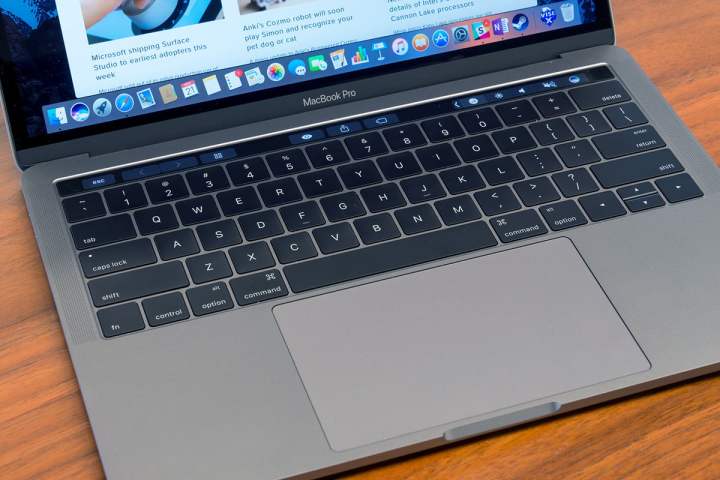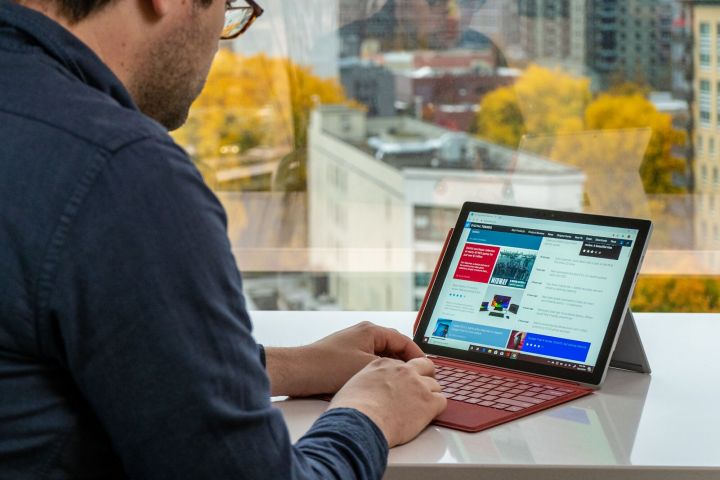Apple and Microsoft have competed for decades on the operating system front, but in more recent years they’ve had competitive hardware, too. The MacBook and Surface lines both have their standouts and strengths, so picking between them isn’t easy. To nail down some firmer recommendations for you, we set the MacBook Pro versus the Surface Pro 7 in a classic head-to-head.
One is a celebrated 2-in-1, the other an iconic workhorse of a laptop with classic Apple styling. Which will come out top when the dust has settled?
Once you’ve determined which model is right for you, take a closer look at the best MacBook deals and the best Microsoft Surface Pro sales available now.
Design

The MacBook Pro has been at the forefront of laptop style for generations, helping to redefine what a premium laptop looks and feels like. While there are many more contenders for the best-looking laptop today, the MacBook Pro stands apart as an exquisitely built machine. While we still don’t quite see the point of the Touch Bar, the overall look and feel of Apple’s MacBook Pro is top-notch.
The Surface Pro 7 is disappointing in terms of its design. Whereas in the past we gave its minor design iterations a pass, this year we’ve finally had enough — as we said in our review, “The Surface Pro 7’s minor revisions are hardly worth a numeric bump from 6 to 7.” It still has large, unsightly bezels, which are looking increasingly out of place in 2019. Indeed, in a laptop marketplace that so often sees just millimeters of extra material surrounding displays, it feels decidedly outdated. It’s also a tad too heavy for comfortable tablet use.
While the Surface Pro 7 might hold on to some style trappings of the past, its inputs are a bit more pleasing. Its Type Cover ($129) is a fantastic accessory that’s a must-have if you plan to do any real typing. Its touchpad is excellent, too; it’s easily one of our favorites of any Windows laptop.
The MacBook Pro’s keyboard is a disappointment by comparison. Apple has gone through several iterations of its butterfly key design and though it is improving, we’re still unimpressed. Sticky and broken keys are common, and the typing experience is far from our favorite, with stiff, overly shallow keys that don’t give you the tactile feedback for a comfortable and efficient typing experience. Fortunately, the touchpad is much better, so if you plan to browse and surf more than type, the lackluster keyboard may not be too much of a problem for you.
As for ports, Apple’s device has either two or four Thunderbolt 3 ports and a headphone jack on the 13-inch version, meaning you’ll probably need adapters for a wide range of external devices. Microsoft has finally embraced USB-C, so the Surface Pro 7 comes with a USB-C port, a USB-A 3.0 port, a headphone jack, a Surface Connect port, a Surface Type Cover connector, and a microSDXC card reader. That means it loses the Mini DisplayPort output from the Surface Pro 6 days.
The Surface Pro 7 is also a 2-in-1 — and our favorite 2-in-1 at that — which means you can ditch the Type Cover and use it as a very functional tablet. That’s something that the MacBook Pro simply cannot do. It’s 100 percent a laptop, where the Surface Pro 7 can be either within a moment’s notice. The Windows 10 tablet mode doesn’t do it many favors, but as an add-on to the full Windows 10 experience, it’s serviceable.
Performance

The entry-level Surface Pro 7 comes with a dual-core Intel Core i3-1005G1 CPU, 4GB of RAM, and 128GB of SSD storage and costs $749. You can change the processor to an i5-1035G4 or i7-1065G7, equip it with 8GB or 16GB of RAM, and have up to 1TB of SSD storage, for between $899 and $2,299.
Every size and configuration of the MacBook Pro now comes with the Touch Bar, and Apple updated its entry-level model earlier in 2019 to come with quad-core 8th-generation Intel i5 processors. You also get 8GB of RAM and a 128GB SSD, plus Intel Iris Plus Graphics 645, all for $1,299. It can be maxed out with a 2.8GHz Intel Core i7 CPU, as well as 16GB of RAM, and up to 2TB of super-fast SSD storage. That’ll set you back $3,099.
While the entry-level MacBook Pro costs a full $550 more than the entry-level Surface Pro 7, you get a much more powerful processor and twice the RAM. Still, if you upgrade the Surface Pro 7 to have an Intel i5 processor and 8GB of RAM it’ll cost you $899, which is still significantly less than the MacBook Pro. Added to that is the fact that Microsoft uses Intel’s 10th-generation chips compared to the 8th-generation versions in the MacBook Pro; our review found this was a “meaningful” step up over the Surface Pro 6.
MacBooks have always been known for their fantastic displays and the latest generation of MacBook Pro doesn’t disappoint. It’s bright and high-contrast with a decent resolution of 2,560 x 1,600. It’s also fantastically colorful, with a wide-ranging color gamut support and an impressively low color error value. The Surface Pro 7’s smaller 12.3-inch display has a higher resolution, a much greater pixel density (2,736 x 1,824 and 267 pixels-per-inch), and is bright and colorful, too. It’s not quite as strikingly bright as the MacBook Pro, but it’s not far behind.
Portability

At 11.5 x 7.9 x 0.33 inches and just 1.7 pounds in tablet mode (1.74 pounds with the i7 chip and around 2.4 pounds with the Type Cover), the Surface Pro 7 is the leaner and lighter device. The MacBook Pro is a slim and relatively light laptop, at 11.97 x 8.36 x 0.59 inches and 3.02 pounds in weight, but it just can’t compete with how easy the Surface Pro 7 is to carry around.
Both the MacBook Pro and Surface Pro 7 are a little disappointing in terms of battery life. The Apple laptop managed just over 10 hours in our 1080p video loop test and has a smaller-capacity battery than previous versions, while the Surface Pro 7 also took a step back, lasting almost an hour and a half less than its predecessor in light web browsing. Both devices can get you through a workday, but you may find yourself reaching for the power cord sooner than you’d like.
The best 2-in-1 is the better laptop

Users often have strong preferences for laptops over 2-in-1s because laptops are the tried and true portable work option over tablets. We have to say this 2-in-1 shocked us when we found that it worked better than similarly classed laptops on the market. Admittedly, the Surface Pro 7 has downsides, such as bulky bezels and a smaller screen. But its numerous benefits, such as a comfortable keyboard, portability, ease of use, and longer battery life, outweigh its disadvantages, making it a better laptop than the MacBook Pro. Its lightweight tablet setting is the icing on the cake.
If you’re sold by a sleek appearance, a bit more power, and an intuitive port selection, the MacBook Pro is worth checking out. The 16-inch MacBook Pro and MacBook Air are worthy alternatives if this is the kind of device you’re seeking. On the other hand, Surface Pro 7 is the better of the two when it comes to excellence across the board. The tablet comes with a charger, but you’ll have to buy a separate Type cover and Bluetooth mouse if you want to level up your game. Even with those additional costs, the Surface Pro 7 is still cheaper than an Apple laptop. This is especially true if you’re in the market for extra storage space.
The MacBook Pro is a solid standard laptop, but if you want to venture out of your comfort zone and try a quality 2-in-1, we recommend the Surface Pro 7.
MacBook Pro
Surface Pro 7
Editors' Recommendations
- The XPS 16 is fighting an uphill battle against the MacBook Pro
- MacBook Pro 16 vs. MacBook Pro 14: The important differences
- Best refurbished MacBook deals: Get a MacBook Air for $140 and more
- Best MacBook deals: Get an Air for $605 and save on M3 MacBook Pro
- Best Surface Laptop and Surface Pro deals: From $450




